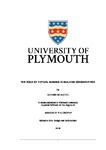THE ROLE OF VIRTUAL IMAGING IN BUILDING CONSERVATION
| dc.contributor.supervisor | Watson, Linda | |
| dc.contributor.author | SCHUETTE, KATHRIN | |
| dc.contributor.other | School of Art, Design and Architecture | en_US |
| dc.date.accessioned | 2018-12-17T11:25:20Z | |
| dc.date.issued | 2018 | |
| dc.identifier | 10321967 | en_US |
| dc.identifier.uri | http://hdl.handle.net/10026.1/13076 | |
| dc.description.abstract |
Conservation is the process of managing changes to significant historic buildings and places. This research explores key conservation concepts, identifying internationally agreed conservation principles and their relationship to the developing role of computer-based visualisation in the conservation process. An emphasis is placed upon documentation that plays an important part in conservation and has begun to recognise virtual imaging as a tool for recording, analysing, interpreting and presenting the cultural heritage. This research focuses in particular upon virtual imaging from the perspective of a building conservator. It addresses both the purpose and possibilities of virtual imaging, which are useful in terms of the act of conservation and more specifically regarding documentation, which itself informs and records the work of a conservator. How can virtual imaging support the practice of the building conservation, with particular reference to documentation including recording and interpretation has been explored through considering the stages of the conservation process. To enable this examination a table has been created to address the question “Where, when and for what purpose an image is supportive in conservation” in relation to the conservation process. This has been informed by the Spinal Steps recommended by E.C.C.O. (The European Confederation of Conservator-Restorer’s Organisation). In addition, to better understanding the potential of this emerging technology different examples of virtual imaging and their uses have been assessed to help identify the benefits for imaging in VIII building conservation. To further investigate the impact of virtual imaging as a conservator’s tool two case studies have been systematically examined to confirm its benefits and which stage of a conservation project they are of optimum use. The overall outcome is that virtual imaging is of particular use to the conservator, and enhances the conservation process and management plan, particularly in terms of documentation and recording historic buildings. | en_US |
| dc.language.iso | en | |
| dc.publisher | University of Plymouth | |
| dc.subject.classification | MPhil | en_US |
| dc.title | THE ROLE OF VIRTUAL IMAGING IN BUILDING CONSERVATION | en_US |
| dc.type | Thesis | |
| plymouth.version | publishable | en_US |
| dc.identifier.doi | http://dx.doi.org/10.24382/440 | |
| dc.identifier.doi | http://dx.doi.org/10.24382/440 | |
| dc.rights.embargodate | 2019-12-17T11:25:20Z | |
| dc.rights.embargoperiod | 12 months | en_US |
| dc.type.qualification | Masters | en_US |
| rioxxterms.version | NA |
Files in this item
This item appears in the following Collection(s)
-
01 Research Theses Main Collection
Research Theses Main


